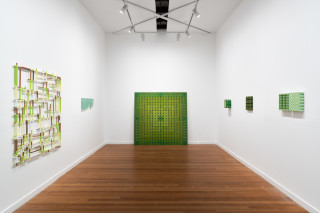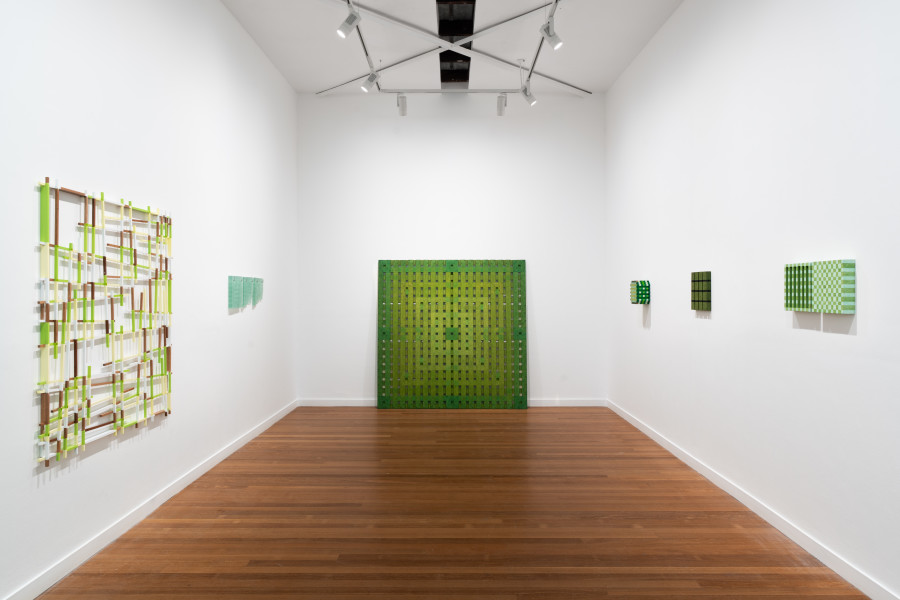Mais honours the voice and essence of the material, whether it be wood or glass. The works evolve gradually, over time—a month, a year, a life-time—each pulling a narrative thread from one to the other as a temporal gauge embodied in structural unity.
–Donna West Brett, University of Sydney
Exhibition Dates: 26 September – 18 October 2025
The ongoing tension in Mais’ work plays out across the spatial elements of repetition and time. Found in both nature and the made world, the grid is the basis for geometrical transcendence, or as Rosalind Krauss once noted, “the grid is a staircase to the Universal.”[1] Although Krauss was referencing Mondrian and Malevich, her observations on the spatial and temporal qualities of the grid as a visual structure resonate with Mais’ life-long investigation of the form. While Krauss often refers to the grid’s formal qualities of flatness, Mais uniquely takes this ubiquitous form into a multiplicity of interpretations and reinterpretations across various media and dimensions.
In encountering time as both linear and folded spatial elements in the world, we come to understand the grid as a means by which we can measure time’s universal, but also impossible, ephemeral presence. Time, for instance, can be thought of in terms of memory, a repetitive, often involuntary process that brings moments of the past into the present like a long thread of knotted twine picking up traces of debris along the way. Mais considers the fold of time through material qualities of timber, paint, glass or metal in her ongoing investigation of the grid’s capacity to integrate and disintegrate spatial planes. A sense of disorientation is often seen in the Grid works, in which specific systems of directional impetus, shape, rhythm, and colour both comply with and break Mais’ applied rules. Such systems, as used across minimalist, geometric, and conceptual art, offer structures for working that are always already endlessly adaptable.
Despite the perceived coolness or distance that can be experienced across minimalist artwork such as those from the 1960s—think here of the Specific Objects of Donald Judd, or works by Carl Andre, Anne Truitt, or indeed Barnett Newman’s paintings—such works at times respond to origins that lie beyond themselves. Newman famously painted a portrait of his father Abraham as an abstracted representation in varying tones of black. Similarly, throughout Mais’ oeuvre lies a biographical spine that permeates the works in a quiet, subtle way as it ebbs along at the edge of things.
The works often embody personal experiences, as in most of Mais’ structures. A trip to Japan, where she learned about the Shou Sugi Ban technique, influenced her choice to leave certain wood elements exposed to honour the support material used in “The Ghost” series, which explores loss and the transient nature of life. The glass works, inspired by time spent in the New Zealand Alps, reflect Mais’ interest in the aesthetic foundations of the grid as a means to explore the disorientation of the surrounding nature. Using a spike to pierce the snow on the cabin deck, she formed a grid pattern in which voids were formed. Over the ensuing days, Mais photographed the grid as the snow melted and morphed into irregular shapes as a form of unmaking. On her return to Sydney, Mais developed this simple repetitive action of forming a grid in snow as the basis for working with a glass artist to construct a series of multilayered slumped glass works. Cold-worked into creation, the Green Ice sculptures reveal both traces of the performative action of piercing the snow and the disintegrating formal qualities of the grid revisited.
The chosen palettes embody a particular overarching mood, in painted surfaces punctuated by varying depths in shallow relief. As Mais has pointed out, “the dominance of the colour green in the exhibition refers to my deceased partner William (Bill) Wright’s love of green, the formal Italian green gardens of few flowers or the wall of green seen through the window of the gallery.”[2] The system here is strict until it is not. The language-based codes and systems of Mais’ sculptural evocations are revealed through colour that makes its presence felt at the work’s edge or underside, often emanating a reflected glow on the gallery wall.
Throughout, Mais honours the voice and essence of the material, whether it be wood or glass. The works evolve gradually, over time—a month, a year, a life-time—each pulling a narrative thread from one to the other as a temporal gauge embodied in structural unity. Mais thinks of the grid as a beginning, as “a meditative point on which to overlay the emotional, the experiential and the narrative—indeed, the feminisation of minimalism.”[3] The ubiquity and power of the grid resonates throughout Mais’ oeuvre in these experiential terms that underpin moments of time as it imposes itself in a narrative that modulates the temporal, the chaotic, and the systematic. This ongoing sense of the grid unravelling, unmaking and making is suggestive of Nietzsche’s thoughts on memory as “loose sheets from the scroll of time,” an imperfect tense of “it was” that remains in ongoing oppositional presence.[4]
– Donna West Brett, University of Sydney
––––
[2] Hilarie Mais in conversation with Donna West Brett.
[3] “Hilarie Mais in conversation with William Wright AM,” in Blair French and Manya Sellers (eds), Hilarie Mais (Sydney: Museum of Contemporary Art Australia, 2017), 36.
[4] Friedrich Nietzsche, “Unmodern Observations,” from Hilarie Mais, Visual Diary, 2023.
 Hilarie Mais Verde
Hilarie Mais Verde
Roslyn Oxley9 Gallery, 2025
 Group Show
Group Show
Roslyn Oxley9 Gallery, 1992
 Hilarie Mais
Hilarie Mais
Roslyn Oxley9 Gallery, 1990
 Group Show
Group Show
Roslyn Oxley9 Gallery, 1990
 Group Show, Strange harmony of contrasts
Group Show, Strange harmony of contrasts
Roslyn Oxley9 Gallery, 1990
 Hilarie Mais
Hilarie Mais
Roslyn Oxley9 Gallery, 1988
 Hilarie Mais
Hilarie Mais
Roslyn Oxley9 Gallery, 1987














